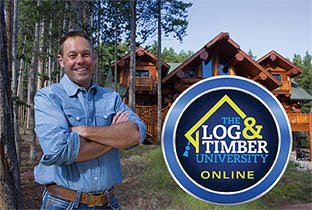In celebration of SepTimber, Timber Home Living is sharing stories from members of the Timber Framers Guild. Learn more about SepTimber here!

By: Steve Amstutz
Photos: Courtesy Steve Amstutz
In l989, my wife Nan and I cut our first timber frame for our home in the Adirondacks. Our daughter grew up here, and we still live in this house that we built with our young bodies and idealistic minds.
Back when we were planning this house, Nan’s brother, Jim Boardman, expressed interest in helping us. In those days, Jim worked for IBM in robotics, so he had an analytically- and scientifically-inclined mind, and he loved working with his hands. We were tickled by his offer, but we were concerned about his safety, especially up in the air, and how he could make a meaningful contribution. Jim has a rare condition called Usher’s Syndrome; he was born Deaf, and he sadly also has a genetically linked, degenerative eye disease named rentinitis pigmentosa. Even then, though he had 20−20 eyesight, his peripheral vision was so reduced that it was like seeing the world through a paper towel tube.
Jim decided that to wire the house would be his optimal contribution. He did his research, got up to speed on the electrical code, and performed an ace job. But it wasn’t woodworking or timber framing.
It is not surprising that Jim became very enamored with timber framing, as it fit his sensibility—he was good with his hands, skilled, methodical, and patient. Plus he liked wood better than Romex. While wiring our house, Jim expressed interest in building a small timber frame barn on his property in the Hudson Valley. He asked if I would help him. Thus was born a wonderful and unique collaboration. I helped him design a 3-bent, 12' x 24' frame, modeled after Jack Sobon’s iconic “Garden Tool Shed.”

So, in the spring of 1990, I sourced timbers for Jim, lent him my sparse collection of timber framing tools, and traveled down to the Hudson Valley a couple of times and laid out one of each joint. I had only our modest house frame under my belt. The biggest saw we had was an 81/4" worm drive, and our mortising technology involved a D-handle drill and a bunch of Forstner bits, which required cleaning up joints with abundant chisel time. Jim was an eager, willing, and highly skilled student. One cutting demonstration per joint was sufficient. Over the summer and into the fall, Jim labored away in his garage and produced a well-crafted and well-organized pile of timbers.
Two factors played into my anxiety about raising this frame. First, Jim wanted his Deaf friends to be the bulk of the hand raising crew. The profoundly Deaf like Jim rely on their hands to communicate in their native language—the beautiful and artistically visual American Sign Language. My sign language was very limited, so we had to rely on Nan, who is bilingual, to be the interpreter for the raising. But still, that would have its challenges. For example, who should the raising crew be watching? Me or Nan? If hands were occupied with heavy timbers, how could workers use them to communicate? I was very concerned about the safety of all involved. Ultimately I recruited the help of a friend who is a fine carpenter and my father, figuring I could at least shout to two of my crew during an exciting moment.
The second factor was that Nan was pregnant with our daughter, and though little Annika’s due date was October 10—the height of beautiful fall weather in the Hudson Valley—babies seldom follow schedules. (Twelve days late, Annika was welcomed into the world by a very worn out Momma and a bleary-eyed Papa, after a rather protracted birth.) Jim was patient, but the weather clock was ticking. So, ten days after the birth, we drove south and got started.

Bent assembly went well, and on the fine morning of November 3, we greeted the crew of about ten folks. As it turned out, the day went off without a hitch, all joinery fitting well. The crew members were fast learners, as well as devoted and attentive. Clearly the hardest and most demanding job was Nan’s, being on her feet much of the day so soon after the birth. She beautifully bridged communication between Deaf and hearing folks and facilitated a very successful and meaningful raising day for all. Plus a superb lunch was served in traditional raising style.
I’d like to say that I gave a meaningful speech about this being the first Deaf timber frame raising in North American history. (Surely it must have been!) Or that I pontificated about the shared cross-cultural camaraderie we had just experienced. Or even that I eloquently praised Jim’s phenomenal accomplishment. But I am sorry to say that I was simply too tired. Regardless, Jim wore a big Cheshire cat smile and his pride on his chest like a medal, as he scrutinized the beautiful frame he had crafted with his own hands and had erected with his friends. It was a day to remember! And a unique example of community spirit at a timber frame raising.

But this story has a recent and very sad twist. In late April of 2020, Jim was diagnosed with ALS or Lou Gehrig’s disease, a degenerative disease in which nerve cells break down and reduce muscle function. It is an ugly disease, and it robs it victims brutally. His skilled hands—the tools of his ability to communicate, so essential to his many projects—have already become sluggish. He can no longer button buttons. And because of the progressing Retinitis Pigmentosa, Jim has a substantially smaller field of vision than he did thirty years ago. Life just isn’t fair in dealing out its hardships. Jim is a proud man, who has been adapting to handicaps his whole life, yet now his world is closing in fast. The pragmatic response has been for Jim and his wife Cathy to pull up roots, sell their Hudson Valley home, and migrate to an assisted living facility close to their daughter in Michigan.
Shared with permission from the Timber Framers Guild magazine, Scantlings.











